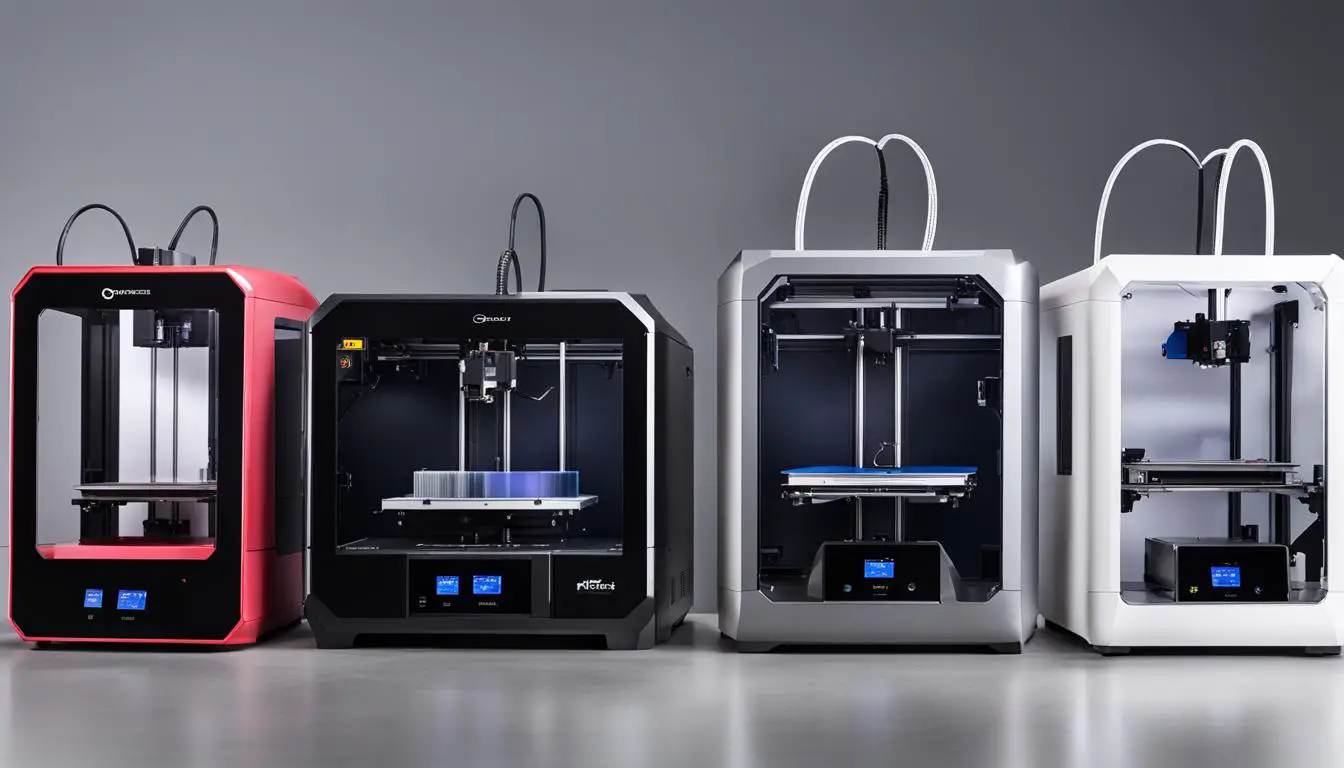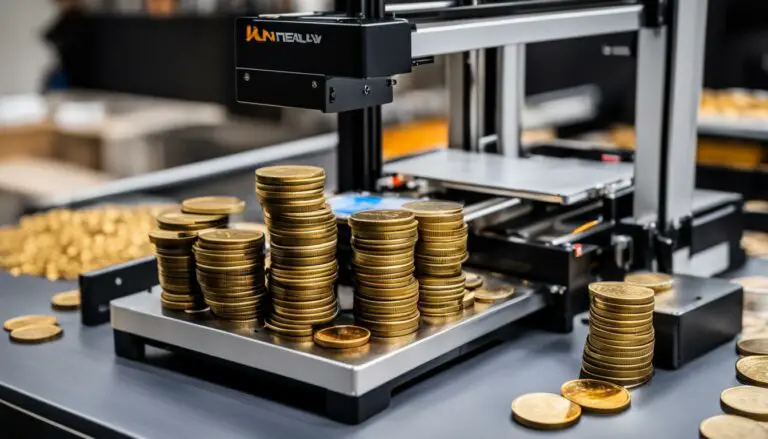3D Printer Buying Decisions: Top Tips & Guides
Originally posted on January 8, 2024 @ 10:31 pm
We are delighted to present our extensive guide to assist you in making a sound purchase of a 3D printer! If you are currently in the market for a 3D printer, you have landed on the perfect resource. We recognize that the abundance of options can cause confusion when selecting the ideal printer. But don’t worry, we are here to offer guidance and help you make a knowledgeable choice!
When it comes to buying a 3D printer, it’s crucial to consider your specific needs and use cases. Are you looking for a printer for hobby purposes or professional use? This distinction will guide you in choosing the appropriate printer type and features that match your requirements.
With numerous 3D printer brands and models on the market, it’s important to compare and read 3D printer reviews to gain insights into their performance and reliability. We know that finding the best 3D printers can be challenging, but our expert advice and guidance will simplify the process for you.
Key Takeaways:
- Consider your specific needs and use cases before buying a 3D printer.
- Read 3D printer reviews to compare different models and brands.
- Expert advice and guidance can help you choose the best 3D printer for your requirements.
- Take into account 3D printer features, prices, and specifications.
- Affordable 3D printers can offer excellent value for hobbyists and beginners.
Understanding the Different Types of 3D Printers
When it comes to 3D printing, there are various types of printers available in the market. Understanding the differences between these printers can help you make an informed decision and choose the one that best suits your needs. In this section, we will explore the different types of 3D printers: FDM printers, SLA printers, SLS printers, DLP printers, and SLM printers.
FDM Printers
FDM printers, also known as filament printers, are widely used for hobby 3D printing. These printers work by melting a filament of thermoplastic material and layering it to create the desired object. FDM printers come in two main styles: Cartesian and Delta. Cartesian printers use a stationary bed and a moving print head, while Delta printers have three arms that move the print head in a coordinated manner. FDM printers are known for their affordability and ease of use, making them a popular choice for beginners.
SLA Printers
SLA printers use a liquid resin and UV lasers to create high-quality prints with intricate details. These printers work by curing the resin layer by layer, resulting in precise and smooth prints. SLA printers are commonly used for applications that require high precision and surface finish, such as jewelry design, dental models, and prototyping. They offer excellent detail resolution and are ideal for creating intricate and delicate objects.
SLS Printers
SLS printers, also known as selective laser sintering printers, use laser and powder materials to create durable and complex prints. These printers work by fusing powdered materials, such as nylon or polyamide, with a laser to build layers of the desired object. SLS printers are known for their ability to produce functional prototypes and end-use parts with high mechanical properties. They are widely used in industries such as automotive, aerospace, and healthcare.
DLP Printers
DLP printers, or digital light processing printers, are similar to SLA printers but use conventional light sources instead of UV light. These printers use a digital micromirror device (DMD) to project light onto the resin, curing it layer by layer. DLP printers offer fast print speeds and are capable of producing highly detailed prints. They are commonly used in industries such as jewelry, prototyping, and dentistry.
SLM Printers
SLM printers, or selective laser melting printers, are used for printing with powdered metals. These printers work by using a high-powered laser to selectively melt and fuse fine metal powders together, layer by layer, to create complex and high-quality metal parts. SLM printers are commonly found in universities, research laboratories, and industries that require the production of metal components with high precision and strength.
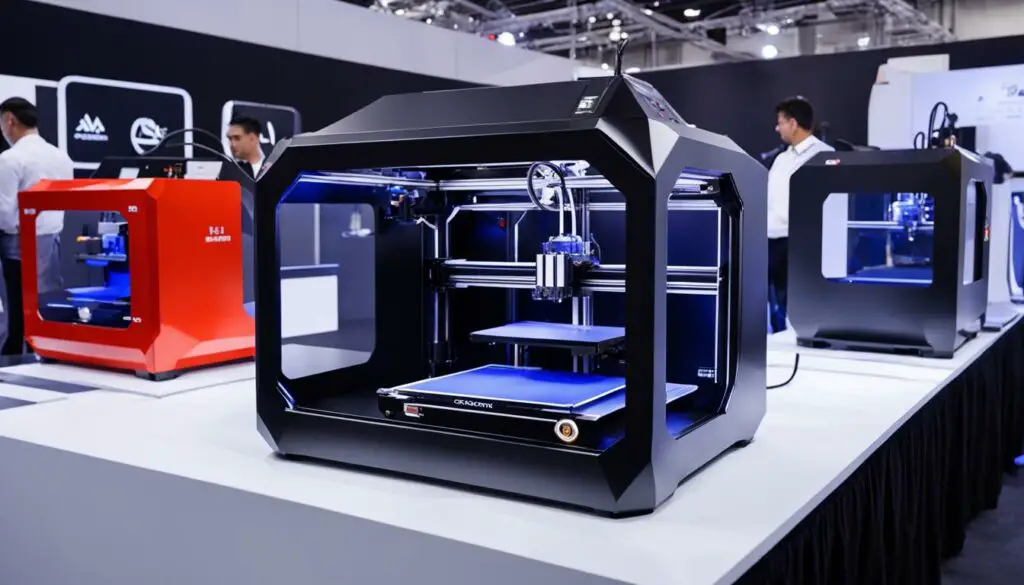
| Type of Printer | Main Technology | Applications |
|---|---|---|
| FDM Printers | Thermoplastic filament deposition | Hobby 3D printing, prototyping |
| SLA Printers | Liquid resin and UV lasers | Jewelry design, dental models, prototyping |
| SLS Printers | Laser and powdered materials | Functional prototypes, end-use parts |
| DLP Printers | Digital light projection | Jewelry, prototyping, dentistry |
| SLM Printers | Selective laser melting of powdered metals | Metal components, research |
Understanding 3D Printing Materials
When it comes to 3D printing, understanding the different materials available is crucial in achieving the desired results. In this section, we will explore the various materials used in 3D printing, including filament and resin.
Filament for FDM Printing
Filament is the most commonly used material in FDM (Fused Deposition Modeling) 3D printing. It is a thermoplastic material that is extruded through a heated nozzle and solidifies to create the printed object layer by layer.
There are different types of filament available, with ABS and PLA being the most popular options:
- ABS (Acrylonitrile Butadiene Styrene): ABS is a durable and versatile material that is commonly used in many applications. It offers good temperature resistance and mechanical strength, making it suitable for functional parts and prototypes.
- PLA (Polylactic Acid): PLA is a biodegradable and environmentally friendly material derived from renewable resources such as corn starch or sugarcane. It is easy to print and produces less odor compared to ABS. PLA is an excellent choice for general-purpose prints and is widely used in the hobbyist community.
Resin for SLA and Other Resin Printers
Resin printers, such as SLA (Stereolithography) printers, use liquid resin that is cured by a light source, typically a UV laser, to create highly detailed and precise prints. Resin offers a level of print quality that is hard to achieve with filament-based printers.
There are different types of resin available, each with its own characteristics:
- Standard Resin: Standard resin is a versatile material suitable for a wide range of applications. It offers good detail resolution and surface finish, making it ideal for producing consumer products, figurines, and architectural models.
- High-Grade Resin: High-grade resin is engineered to provide enhanced mechanical properties, such as strength and flexibility. It is commonly used in engineering applications and functional prototypes that require specific performance requirements.
- Medical-Grade Resin: Medical-grade resin is biocompatible and meets specific standards for use in the medical and dental industries. It is used for producing anatomical models, surgical guides, and dental prosthetics.
It’s important to consider the specific requirements of your prints when choosing the right material. Factors such as mechanical properties, print quality, cost, and post-processing considerations should all be taken into account.
Here is a comparison table summarizing the key characteristics of filament and resin:
| Material | Properties | Applications |
|---|---|---|
| Filament (ABS, PLA) | Durable, versatile, environmentally friendly | Functional parts, prototypes, general-purpose prints |
| Resin (Standard, High-Grade, Medical-Grade) | High level of detail, precision, enhanced mechanical properties (for high-grade and medical-grade) | Consumer products, figurines, architectural models, engineering applications, medical and dental applications |
Understanding the properties and applications of different 3D printing materials empowers you to make informed decisions and achieve the best results for your specific needs.
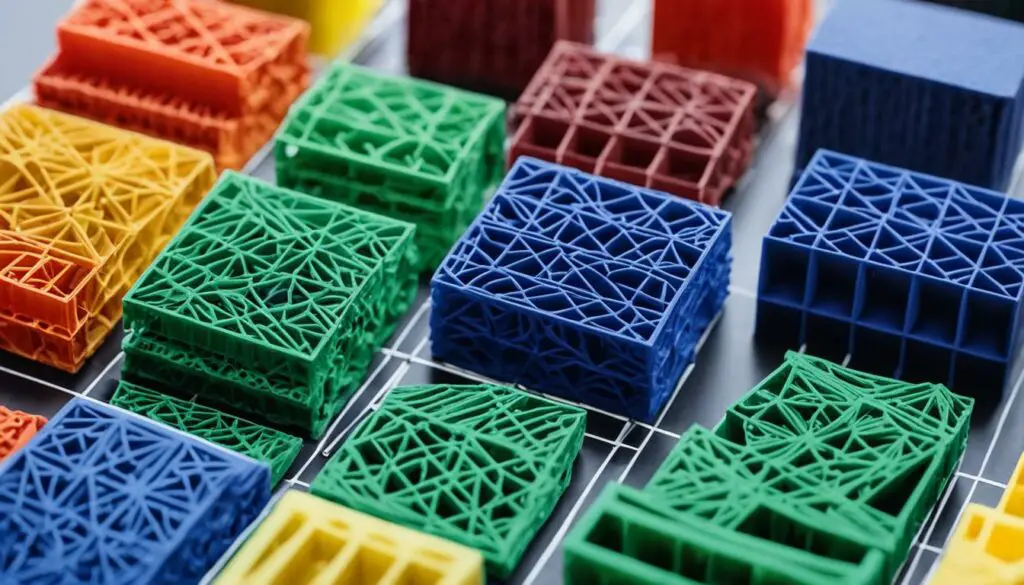
Important 3D Printer Specifications
When evaluating potential 3D printers, it’s crucial to consider key specifications that will impact the quality and capabilities of your prints. Let’s take a closer look at the important specifications you should pay attention to:
- Resolution: The resolution of a 3D printer refers to the level of detail it can produce in a printed object. Higher resolutions result in more intricate and precise prints, while lower resolutions may sacrifice some detail but can still offer good quality. It’s important to consider the level of resolution required for your specific prints to ensure optimal results.
- Speed: While speed is a consideration, it’s not always the most crucial factor. Slower printers can provide higher-quality prints with finer details and improved accuracy. On the other hand, faster printers may sacrifice some level of detail. Assess your needs and find the right balance between speed and print quality for your specific projects.
- Supported Materials: The range of materials that a 3D printer can handle is an essential consideration. Different printers support different materials, including various filaments and resins. Consider the types of materials you plan to use for your prints and ensure that the printer you choose is compatible. Additionally, take into account the associated costs of the materials as it can vary.
- Print Capacity (Build Area): The print capacity, also known as the build area, refers to the maximum size of printable objects that a 3D printer can produce. It’s important to select a printer with a build area that aligns with your intended print sizes. Take into consideration the dimensions of the objects you plan to print to ensure they will fit within the printer’s specifications.
By evaluating these important specifications, you can make an informed decision when selecting a 3D printer that meets your specific requirements and produces high-quality prints with the desired level of detail and accuracy.
| Specification | Description |
|---|---|
| Resolution | The level of detail in a printed object. Higher resolutions result in more intricate and precise prints, while lower resolutions sacrifice some detail. |
| Speed | The rate at which a printer can produce prints. Slower printers offer higher-quality prints, while faster printers may sacrifice some level of detail. |
| Supported Materials | The range of materials that a printer can handle. Different printers support different types of filaments and resins. |
| Print Capacity (Build Area) | The maximum size of printable objects that a printer can produce. It’s crucial to choose a printer with a build area that accommodates your intended print sizes. |
By considering and comparing these specifications, you can confidently select the right 3D printer for your needs.
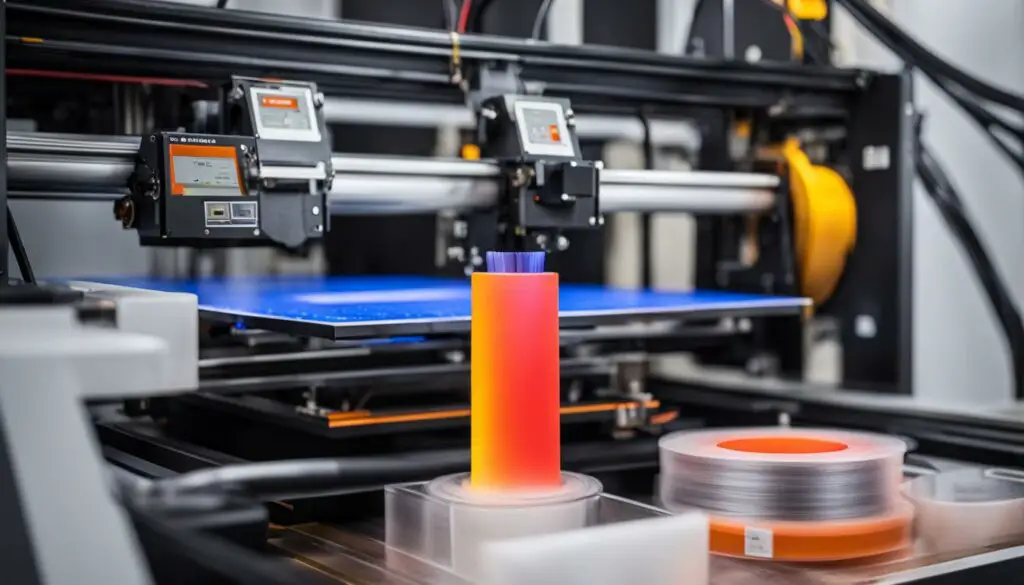
Important Factors to Consider before Buying a 3D Printer
When it comes to purchasing a 3D printer, there are several key factors to consider that can significantly impact your printing experience. By carefully evaluating these aspects, you can make a well-informed decision and select the perfect printer for your needs.
- Budget: Determine your budget and how much you are willing to invest in a 3D printer. Consider both the upfront cost of the printer and any ongoing expenses such as materials and maintenance.
- Print Purposes: Identify the specific purposes for which you intend to use the printer. Are you planning to create high-quality prototypes, functional parts, or artistic models? Understanding your print purposes will help determine the necessary specifications and capabilities.
- Desired Properties: Consider the desired properties of the printer that align with your needs. This includes factors such as connectivity options (Wi-Fi, USB, SD card), assembly preferences (pre-assembled or DIY kit), and the ability to print with different materials.
- Printing Speed: Evaluate the printing speed of the printer, which determines how quickly your prints will be completed. Keep in mind that faster printing speeds may compromise print quality, so it’s essential to find the right balance for your specific requirements.
- Print Size: Determine the maximum print size or build volume that suits your needs. Consider the dimensions of the objects you plan to print to ensure they fit within the printer’s capabilities.
- Extruder Type: Choose between a direct-drive or Bowden extruder. Direct-drive extruders are located close to the print head, offering better control, while Bowden extruders use a tube to guide the filament, enabling faster movements.
By taking into account these important factors, you can narrow down your options and find a 3D printer that fits your budget, fulfills your specific print purposes, and offers the desired properties and capabilities. This comprehensive evaluation process ensures that you make an informed decision and acquire a printer that will meet your expectations, setting you up for successful and satisfying 3D printing experiences.
| Factors | Considerations |
|---|---|
| Budget | Determine your budget and consider ongoing expenses. |
| Print Purposes | Identify the specific purposes for your prints. |
| Desired Properties | Consider connectivity, assembly, and material compatibility. |
| Printing Speed | Evaluate the speed of the printer and its impact on quality. |
| Print Size | Determine the maximum size of prints the printer can handle. |
| Extruder Type | Choose between direct-drive and Bowden extruders. |
Conclusion
Buying a 3D printer is no easy task. With so many options available, it can be overwhelming to make the right decision. However, by considering your specific needs, understanding the different types of 3D printers and materials, and evaluating important specifications, you can confidently choose the best 3D printer that suits your requirements.
First and foremost, think about your budget. Determine how much you are willing to spend on a 3D printer, keeping in mind that higher-priced models often offer more advanced features and better print quality.
Next, consider your desired print purposes. Are you looking to create intricate designs for hobby purposes or durable prototypes for professional use? Understanding your specific needs will help you narrow down the 3D printer options.
Furthermore, pay attention to the desired properties of the printer. Think about factors such as connectivity options, assembly preferences, printing speed, print size, and extruder type. These features can greatly impact your overall experience with the printer and the quality of your prints.
Lastly, we recommend referring back to the information provided in this guide, including the different types of 3D printers, materials, and important specifications. By considering all these factors, you can make an informed decision and confidently choose the best 3D printer that meets your needs. Happy printing!
FAQ
What factors should I consider when buying a 3D printer?
When purchasing a 3D printer, it’s important to consider your specific needs and use cases, the type of printer, the printing material, and important specifications such as resolution, speed, supported materials, and print capacity.
What are the different types of 3D printers?
The different types of 3D printers include FDM printers (filament printers), SLA printers, SLS printers, DLP printers, and SLM printers. Each type has its own advantages and is suitable for different applications.
What are the common 3D printing materials?
The common 3D printing materials include filament (used in FDM printers) such as ABS and PLA, and resin (used in SLA and other resin printers) which can vary in quality, including standard, high-grade, and medical-grade resins.
What are the important specifications to consider when buying a 3D printer?
The important specifications to consider when buying a 3D printer are resolution (level of detail), speed, supported materials, and print capacity (build area). Evaluating these specifications will help ensure that the printer aligns with your requirements.
What factors should I consider before buying a 3D printer?
Factors to consider before buying a 3D printer include your budget, desired print purposes, desired properties of the printer (such as connectivity options and assembly preferences), printing speed, print size, and extruder type (direct-drive or Bowden).

